Clamps
Clamps are used for connecting exhaust system slip joints:
| • | Saddle/U-bolt |
| • | Guillotine |
Exhaust Manifold Pipe
The front exhaust pipe incorporates a stainless steel braided sleeve over a flexible bellows section along with the catalytic converter. The entire pipe assembly is welded joint construction and is only serviced as an assembly.
Exhaust Manifold/Heated Oxygen (O2) Sensor - L61
The exhaust manifold used on the L61 engines are cast iron. The oxygen sensor is located in the exhaust manifold of all engines.
Exhaust Manifold/Heated Oxygen (O2) Sensor - L81
The exhaust manifold used on the L81 engines are formed stainless steel. The heated oxygen sensors are located in the exhaust manifold of all engines.
Exhaust System Production Installation - L61
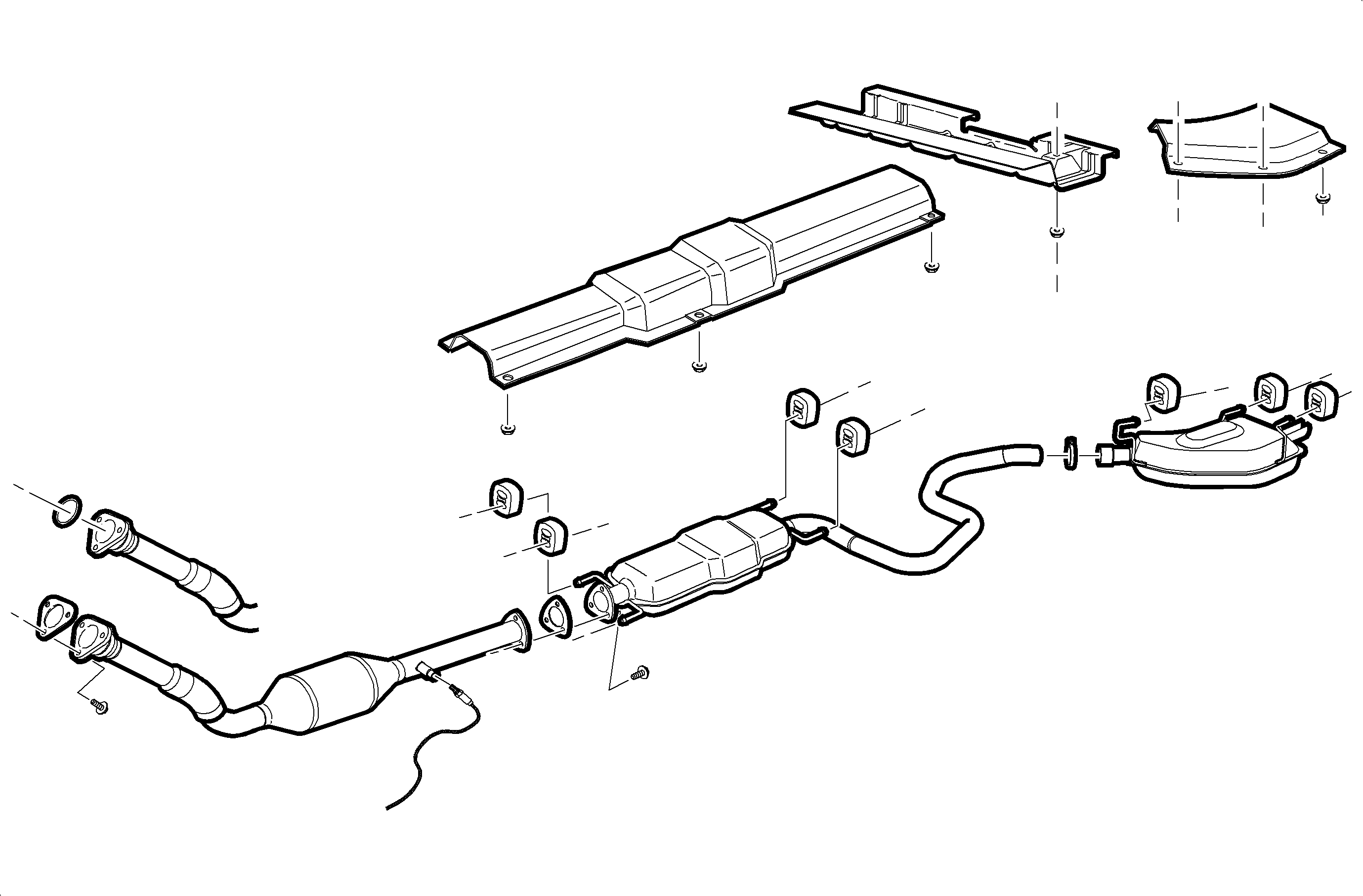
Exhaust System Production Installation - L81
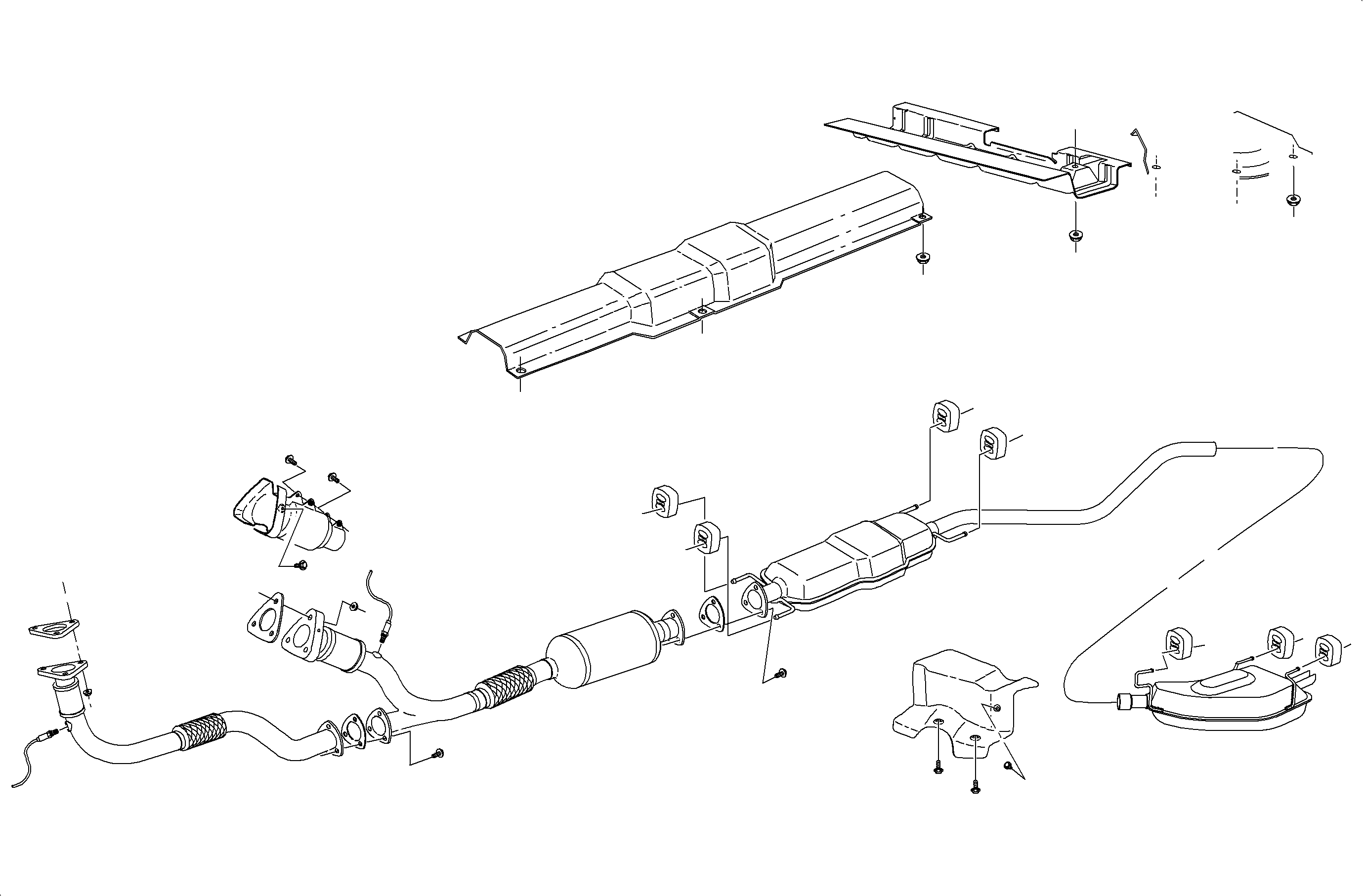
Check the complete exhaust system and nearby body areas for broken, damaged, missing, or mis-positioned parts, open seams, holes, loose connections, or other deterioration which could permit exhaust fumes to seep into the passenger compartment. Dust or water in the passenger compartment may be an indication of a problem in one of these areas. Any damage should be corrected immediately.
Annoying rattles and noise vibrations in the exhaust system are usually caused by misalignment of parts. When aligning the system, leave all bolts or nuts loose until all parts are properly aligned, then tighten, working from the rear.
Periodic maintenance of the exhaust system is not required. When the vehicle is raised for service, check the general condition of the three way catalytic converter, pipes, mufflers, and heat shields. The steel used in the exhaust system is resistant to corrosion caused by exhaust gases, but rapidly shows surface corrosion on the outside. This surface corrosion is not a cause for replacement.
The installation of exhaust system supports is very important, since improperly installed supports can cause annoying vibrations which are difficult to diagnose.
Exhaust system performance complaints, such as excessive back pressure, are noticeable by their effect on engine performance. Other faulty vehicle components, such as emission control devices, have similar effects on engine performance and may be characterized by the same symptoms or complaints.
Exhaust System
Make sure that there is adequate clearance between the components of the exhaust system and all points of the underbody to avoid possible overheating of the floor pan and possible damage tot he passenger compartment insulation and trim materials.
Check the complete exhaust system and nearby body areas for broken, damaged, missing, or mis-positioned parts, open seams, holes, loose connections, or other deterioration which could permit exhaust fumes to seep into the passenger compartments. Dust or water in the passenger compartment may be an indication of a problem in one of these areas. Any damage should be corrected immediately.
Annoying rattles and noise vibrations in the exhaust system are usually caused by misalignment of parts. When aligning the system, leave all bolts or nuts loose until all parts are properly aligned, then tighten, working from the rear.
Periodic maintenance of the exhaust system is not required. When the vehicle is raised for service, check the general condition of the three way catalytic converter, pipes, mufflers, and heat shields. The steel used in the exhaust system is resistant to corrosion caused by exhaust gases, but rapidly shows surface corrosion on the outside. This surface corrosion is not a cause for replacement.
The installation of exhaust system supports is very important, since improperly installed supports can cause annoying vibrations which are difficult to diagnose.
Exhaust system performance complaints, such as excessive back pressure, are noticeable by their effect on engine performance. Other faulty vehicle components, such as emission control devices, have similar effects on engine performance and may be characterized by the same symptoms or complaints.
Exhaust/Resonator Pipe
The exhaust/resonator pipe is part of a welded exhaust system and is serviced without the muffler.
Three Way Catalytic Converter
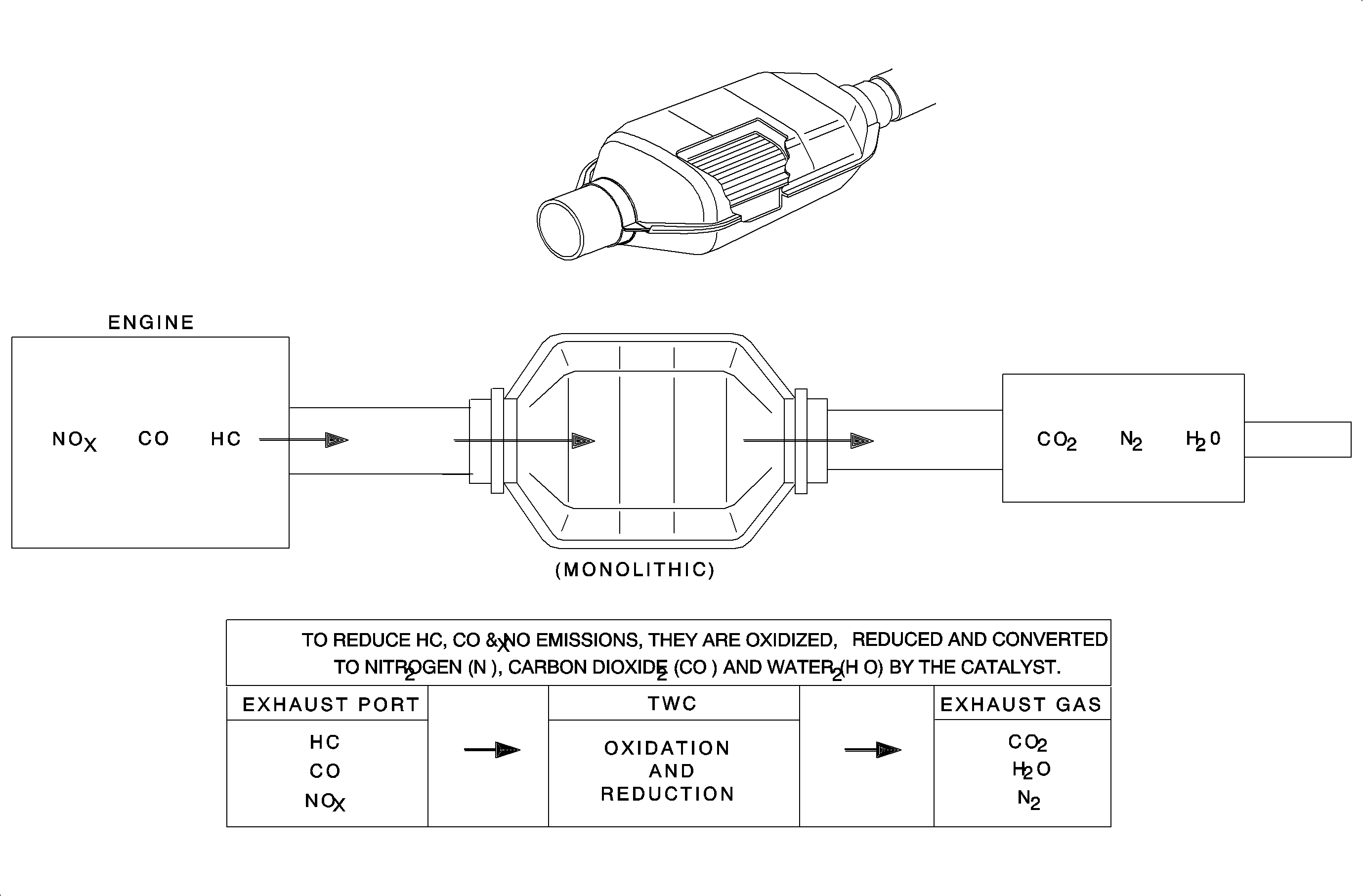
The three way catalytic converter is an emission control device added to the exhaust system to reduce pollutants in the exhaust gas stream and requires the use of unleaded fuel only.
The three way catalytic converter coating contains platinum and rhodium which lowers the levels of oxides of nitrogen (NOx) as well as hydrocarbons (HC) and carbon monoxide (CO).
Periodic maintenance of the exhaust system is not required. If the vehicle is raised for other service, it is advisable to check the condition of the complete exhaust system.
Front Oxygen Sensor (O2S) -- L61
The front oxygen sensor (O2S) is mounted in the exhaust system where it can monitor the oxygen content of the exhaust gas stream. An oxygen sensor acts as an electrochemical cell, or battery, to produce a voltage in response to the oxygen content in the exhaust stream compared to the oxygen content of the atmosphere. A lean mixture, or high oxygen content in the exhaust, will produce a low voltage and a rich mixture, or a low oxygen content in the exhaust, will produce a high voltage. The oxygen content in the exhaust reacts with the oxygen sensor to produce a voltage output. This voltage ranges from approximately 100 millivolts (0.1 volts) for a high oxygen-lean mixture, to 900 millivolts (0.9 volts) for a low oxygen-rich mixture.
Important: A DTC P0171, P0172, P0173, and P0174 usually indicates a rich or lean engine operation, rather than a defective oxygen sensor or circuit. Therefore, it is important that the Fuel System Check be used to diagnose these codes.
By monitoring the voltage output of the oxygen sensor, the PCM will know how to adjust the fuel mixture. A lean mixture has low voltage and produces a rich command. A rich mixture has high voltage and produces a lean command.
Rear Heated Oxygen Sensor (HO2S-2) -- L61
The heated rear oxygen sensor, mounted behind the catalytic converter, monitors oxygen content in the exhaust to determine the efficiency of the catalytic converter. The HO2S-2 is a 4 wire sensor. Two of the wires heat the sensor (B+ and ground) and the other 2 wires are the signal reference and ground. The sensor acts as an electro chemical cell, or battery, to produce a voltage in response to the oxygen content in the exhaust. A bias voltage, voltage sent from the PCM, is between 350-550 mV which is the voltage the PCM will see when the sensor is inactive or cold. As the heater and the converter heat the sensor up to around 275°C (527°F), the sensor will produce its own voltage to counteract this bias voltage. Low voltage from the sensor indicates high oxygen content, or a lean mixture, whereas high voltage indicates low oxygen content, or a rich mixture. The wires to the sensor carry air reference which is used to compare differences in oxygen from the atmosphere to the exhaust stream.
The rear HO2S-2 will react slower than the front O2S due to the oxygen storage in the catalytic converter. The rear oxygen sensor is used only for converter efficiency, not for A/F ratio control.
The rear oxygen sensor operates between 275°C (527°F) to 850°C (1562°F).
HO2S Sensor 1 -- L81
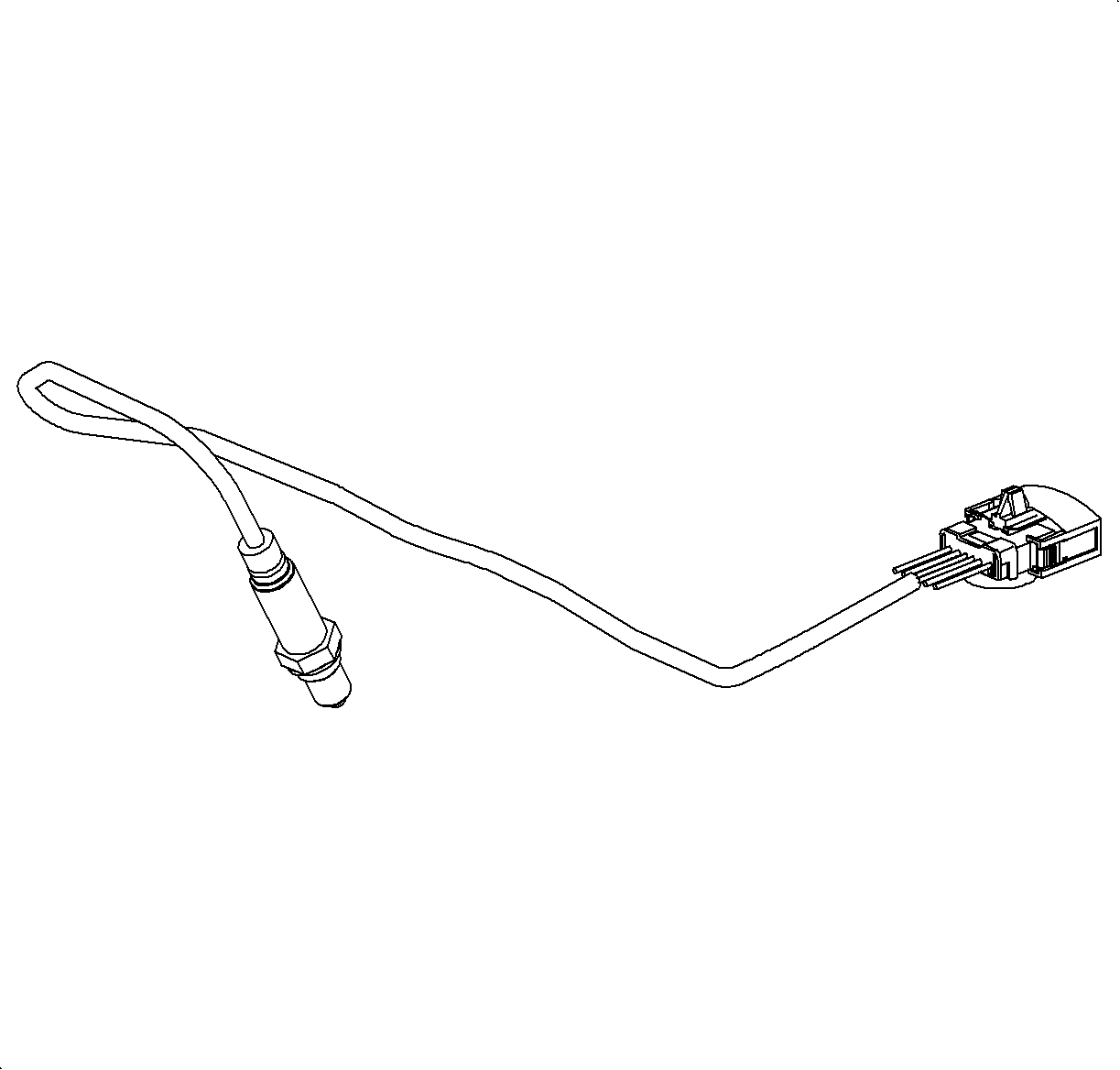
This vehicle uses wide-band lambda sensors to monitor oxygen content of the exhaust gas stream. These sensors compare the oxygen content of exhaust gas to the oxygen content of fresh reference air. The heated oxygen sensor has a fixed voltage on its signal wire, but varies the pump current to the oxygen sensor to indicate the vehicle's current air/fuel ratio. The ECM interprets this current as a lambda value where a lambda of 1 means a stoichometric ration (14.7:1). A value higher than 1 indicates a lean condition, and a lambda less than 1 indicates a rich condition. During closed loop operation, the ECM compensates for a rich or lean condition by decreasing or increasing the injector pulse width as necessary. These oxygen sensors do not switch between rich and lean states to drive to a commanded air/fuel ratio. The use of the lambda gives a very precise air/fuel reading, and allows the vehicle to quickly reach the commanded state without switching.
When the engine temperature is below 37°C (99°F), the vehicle operates in open loop. The ECM begins pulsing the oxygen sensor heater ground to minimize the time it will take to reach closed loop fuel control. The oxygen sensor should begin functioning within 12 seconds after the heater reaches the proper temperature for operation. The heater is activated at key ON.
HO2S Sensor 2 -- L81
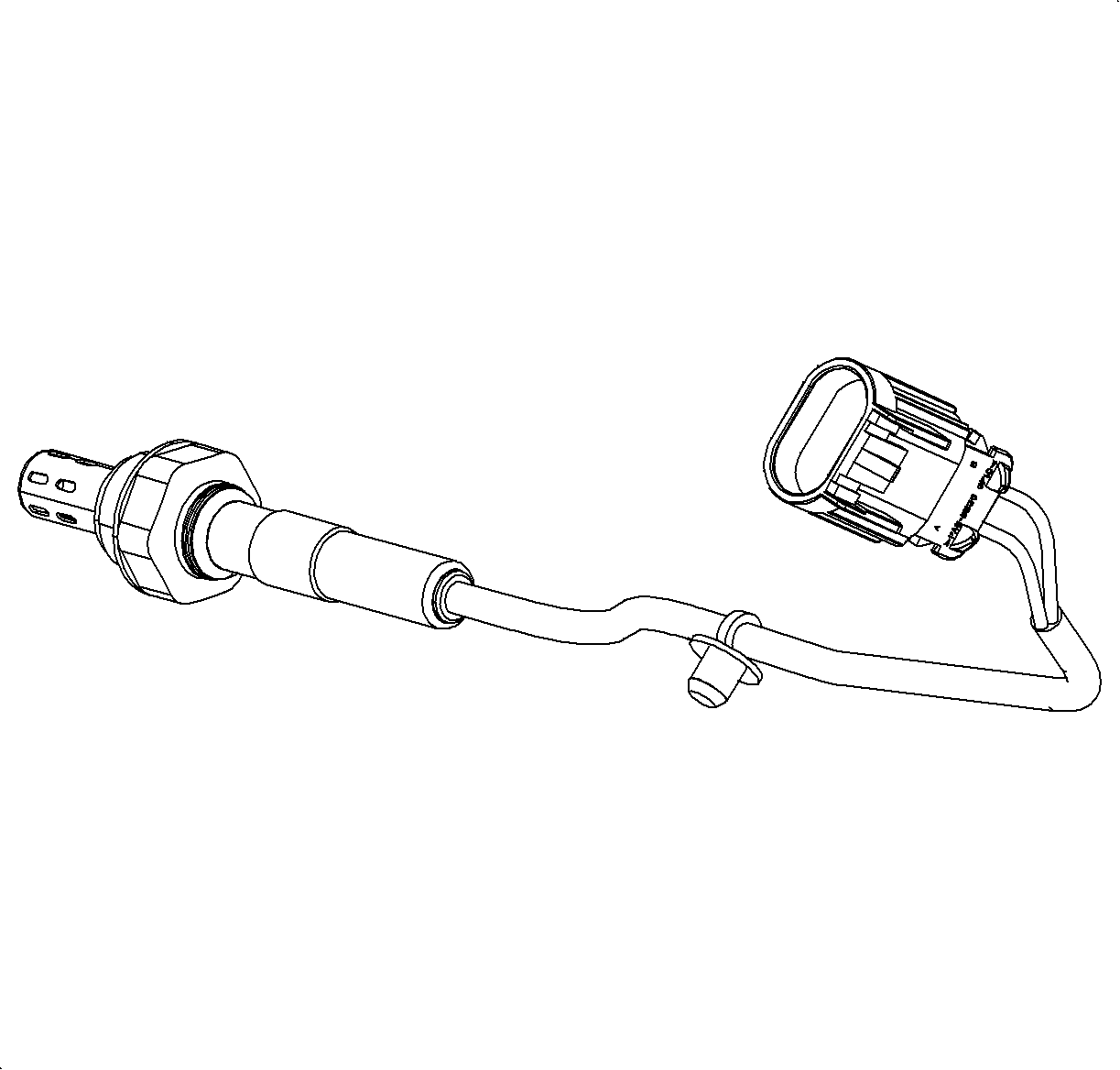
The heated oxygen sensor 2, mounted behind the pup converter, monitors oxygen content in the exhaust to determine the efficiency of the pup converter. This oxygen sensor is used only for converter efficiency, not for air/fuel ratio control. The sensor acts as an electrochemical cell, or battery, to produce a voltage in response to the oxygen content in the exhaust. A bias voltage, from the ECM, is between 350-550 mV and is what the ECM sees when the sensor is inactive or cold. As the heater and the converter temperature heat the sensor up to around 275°C (527°F), the sensor will produce its own voltage to counteract the bias voltage. Low voltage from the sensor indicates high oxygen content, or a rich mixture. The wires to the sensor carry reference air which is used to compare difference in oxygen from the atmosphere to the exhaust stream.
Hangers And Isolators
The exhaust system is supported by free hanging rubber mountings which permit some movement of the exhaust system but do not permit the transfer of noise and vibration into the passenger compartment.
The installation of exhaust system supports/isolators is very important as improperly installed supports/isolators can cause annoying vibrations which can be difficult to diagnose.
Muffler
The muffler is part of the exhaust system and is serviced.
Shields
The heat shields are aluminum. They prevent exhaust system heat from penetrating the floor of the vehicle or the fuel tank. Inspect the shields for cracks and tears. Shields must always be re-installed if they are removed for exhaust system or body repairs.
